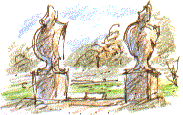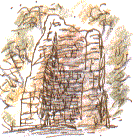 |
Gog and MagogMonday, 29th January 2001, West Yorkshire |
![]()
![]()
![]()
![]()
![]()
![]() This Month
Rocks
History
Workshop
Links
Home Page
This Month
Rocks
History
Workshop
Links
Home Page
![]()
 THE RUINS of Thornhill Hall are surrounded by a moat, quite a rare survival in this area. Moats were only partly defensive and were often probably more of a status symbol. However this moat was destined to withstand at least one siege, which took place in 1648 towards the end of the English Civil War. The hall isn't in a very defensible position. The attacking Parliamentarians positioned their cannons on the ridge that overlooks it and were able to use the farm buildings, which still stand nearby, as cover during their attack. The siege ended when the powder magazine at the Hall exploded, apparently as the result of an accident.
THE RUINS of Thornhill Hall are surrounded by a moat, quite a rare survival in this area. Moats were only partly defensive and were often probably more of a status symbol. However this moat was destined to withstand at least one siege, which took place in 1648 towards the end of the English Civil War. The hall isn't in a very defensible position. The attacking Parliamentarians positioned their cannons on the ridge that overlooks it and were able to use the farm buildings, which still stand nearby, as cover during their attack. The siege ended when the powder magazine at the Hall exploded, apparently as the result of an accident.The only part that is now left standing is the base of a great chimney, structurally the strongest part of the house. Partially burned logs stand stacked in the hearth once again today as a work-party from Kirklees Council thins out the trees on the island.
 Twin statues carved in limestone stand on the island by the moat, surveying the ruins. They're named 'Gog and Magog' after the legendary giants of British folklore. In this case I think they get their names simply because they're a pair. They look more like eagles or griffins to me.
Twin statues carved in limestone stand on the island by the moat, surveying the ruins. They're named 'Gog and Magog' after the legendary giants of British folklore. In this case I think they get their names simply because they're a pair. They look more like eagles or griffins to me.I've been visiting the spot for years and it's only today that I've realised what they were originally made for. The scalloped back, which I had thought was a stylised way of depicting their wings, is evidently a rainwater channel. I guess that they were gargoyles from some imposing building; a cathedral or a college for example. The square plinths that they stand on, which are carved from the same block held them in place in the wall. Water poured away down either side of the creatures' heads. It's strange to think of the forgotten highlife these creatures once enjoyed as they decorated some high status building several centuries ago.
Kitchen Accounts
Some of the kitchen accounts for the Hall still survive. Here's a selection of items recorded on Monday, 19th January 1629. The prices are in shillings and pence;| Store 30 cast of manchett (bread) of 2 pecks of flowre 2 sheeps carkasses 4 couple of rabbitts Remainder 34 capons 6 hennes 32 geese 4 turkies 39 partridges |
17 joints of mutton 17.0 3 joints of veal 3.6 2 wild ducks 1.4 3 widgeons 1.0 4 snipes 0.8 1 calfes head 0.6 4 calfes feet 0.2 2 neats feat 0.4 14 lb of butter 5.10 30 eggs 0.7 |
Winter flowers
 THE SHRUB Garriya elliptica, the Coast Silk Tassle, growing in the border in the garden behind Old Rectory, Thornhill Park, has long grey-green catkins at the moment. It was introduced to this country from its native Californian chaparral and forest, by the Scottish plant-hunter David Douglas (1798-1834), the man who introduced the Douglas Fir to Europe. He named this now popular garden shrub after Nicholas Garry of the Hudson's Bay Company.
THE SHRUB Garriya elliptica, the Coast Silk Tassle, growing in the border in the garden behind Old Rectory, Thornhill Park, has long grey-green catkins at the moment. It was introduced to this country from its native Californian chaparral and forest, by the Scottish plant-hunter David Douglas (1798-1834), the man who introduced the Douglas Fir to Europe. He named this now popular garden shrub after Nicholas Garry of the Hudson's Bay Company.In the woodland a planted variety of Butterbur is now in fragrant flower.
Cup Fungus
A cluster of brown cup fungi, which resemble certain kinds of pasta, each an inch or two across, grows from a pile of horse manure and old straw that have been cleared from the stables.![]()
Richard Bell,
wildlife illustrator
E-mail; 'richard@willowisland.co.uk'
![]() Next page
Previous page
This day last year
This month
Nature Diary
Home Page
Next page
Previous page
This day last year
This month
Nature Diary
Home Page
![]()